2014 KIA Sedona jump start
[x] Cancel search: jump startPage 276 of 382
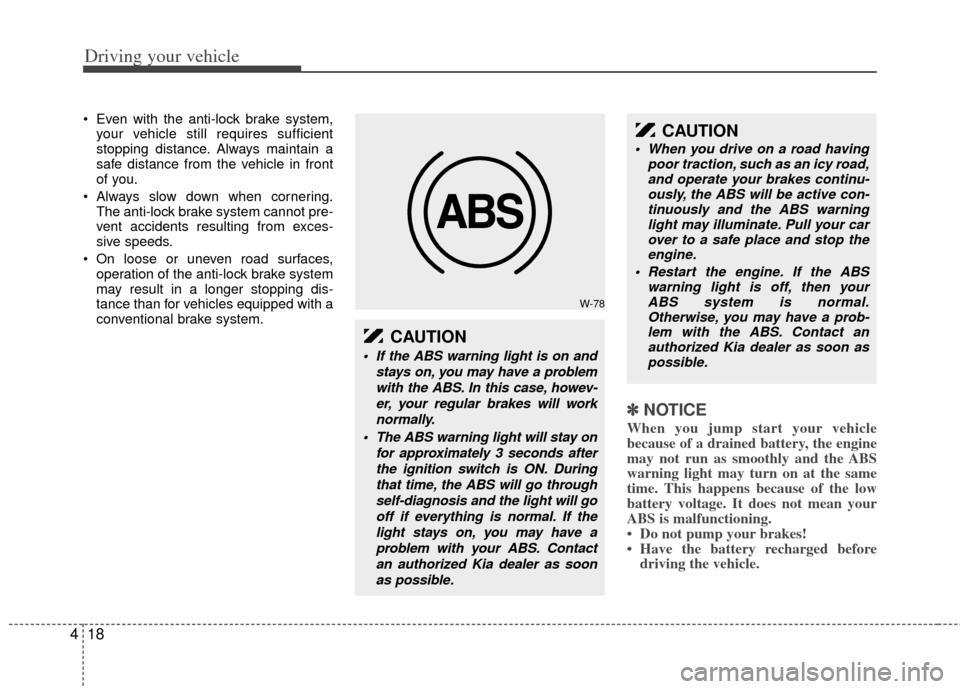
Driving your vehicle
18
4
Even with the anti-lock brake system,
your vehicle still requires sufficient
stopping distance. Always maintain a
safe distance from the vehicle in front
of you.
Always slow down when cornering. The anti-lock brake system cannot pre-
vent accidents resulting from exces-
sive speeds.
On loose or uneven road surfaces, operation of the anti-lock brake system
may result in a longer stopping dis-
tance than for vehicles equipped with a
conventional brake system.
✽ ✽ NOTICE
When you jump start your vehicle
because of a drained battery, the engine
may not run as smoothly and the ABS
warning light may turn on at the same
time. This happens because of the low
battery voltage. It does not mean your
ABS is malfunctioning.
• Do not pump your brakes!
• Have the battery recharged before
driving the vehicle.
W-78
CAUTION
If the ABS warning light is on and
stays on, you may have a problemwith the ABS. In this case, howev-er, your regular brakes will worknormally.
The ABS warning light will stay on for approximately 3 seconds afterthe ignition switch is ON. Duringthat time, the ABS will go throughself-diagnosis and the light will gooff if everything is normal. If thelight stays on, you may have aproblem with your ABS. Contactan authorized Kia dealer as soonas possible.
CAUTION
When you drive on a road having poor traction, such as an icy road,and operate your brakes continu- ously, the ABS will be active con-tinuously and the ABS warning light may illuminate. Pull your carover to a safe place and stop the engine.
Restart the engine. If the ABS warning light is off, then yourABS system is normal. Otherwise, you may have a prob-lem with the ABS. Contact an authorized Kia dealer as soon aspossible.
Page 287 of 382

429
Driving your vehicle
We recommend that you carry emer-gency equipment, including a window
scraper, windshield de-icer, a bag of
sand or salt, flares, a small shovel and
jumper cables.
Make sure you have sufficient ethyl- ene-glycol coolant in the radiator.
Check the battery condition and cables. Cold temperatures reduce the
capacity of any battery, so it must be in
excellent condition to provide enough
winter starting power.
Make sure the engine oil viscosity is suitable for cold weather.
Check the ignition system for loose connections and damage.
Use antifreeze-formulated windshield washer fluid. (Do not use engine
coolant antifreeze.)
Do not use the parking brake if it might freeze. When parking, shift to P (Park)
with an automatic transaxle and block
the rear wheels.Snow tires
If you mount snow tires on your Kia,
make sure they are radial tires of the
same size and load range as the original
tires. Mount snow tires on all four wheels
to balance your vehicle’s handling in all
weather conditions. Keep in mind that the
traction provided by snow tires on dry
roads may not be as high as your vehi-
cle's original equipment tires. You should
drive cautiously even when the roads are
clear. Check with the tire dealer for max-
imum speed recommendations.
Do not install studded tires without firstchecking local, state and municipal regu-lations for possible restrictions againsttheir use.
WINTER DRIVING
WARNING- Snow tire size
Snow tires should be equivalent in
size and type to the vehicle's stan-
dard tires. Otherwise, the safety and
handling of your vehicle may be
adversely affected.
Page 300 of 382
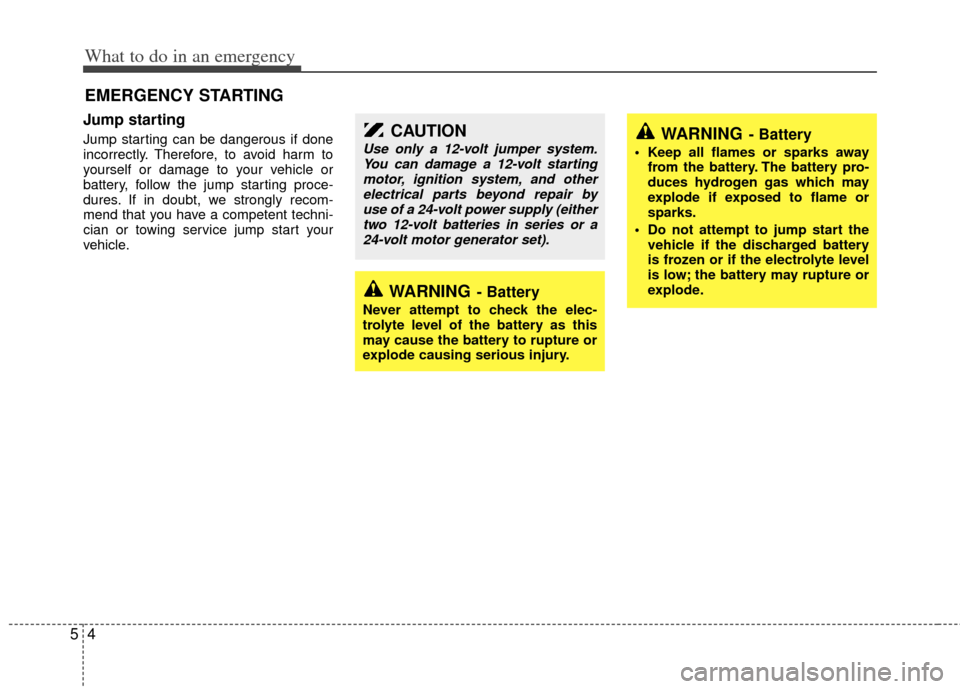
What to do in an emergency
45
EMERGENCY STARTING
Jump starting
Jump starting can be dangerous if done
incorrectly. Therefore, to avoid harm to
yourself or damage to your vehicle or
battery, follow the jump starting proce-
dures. If in doubt, we strongly recom-
mend that you have a competent techni-
cian or towing service jump start your
vehicle.WARNING- Battery
• Keep all flames or sparks awayfrom the battery. The battery pro-
duces hydrogen gas which may
explode if exposed to flame or
sparks.
Do not attempt to jump start the vehicle if the discharged battery
is frozen or if the electrolyte level
is low; the battery may rupture or
explode.
WARNING- Battery
Never attempt to check the elec-
trolyte level of the battery as this
may cause the battery to rupture or
explode causing serious injury.
CAUTION
Use only a 12-volt jumper system.You can damage a 12-volt starting motor, ignition system, and otherelectrical parts beyond repair by use of a 24-volt power supply (eithertwo 12-volt batteries in series or a 24-volt motor generator set).
Page 301 of 382
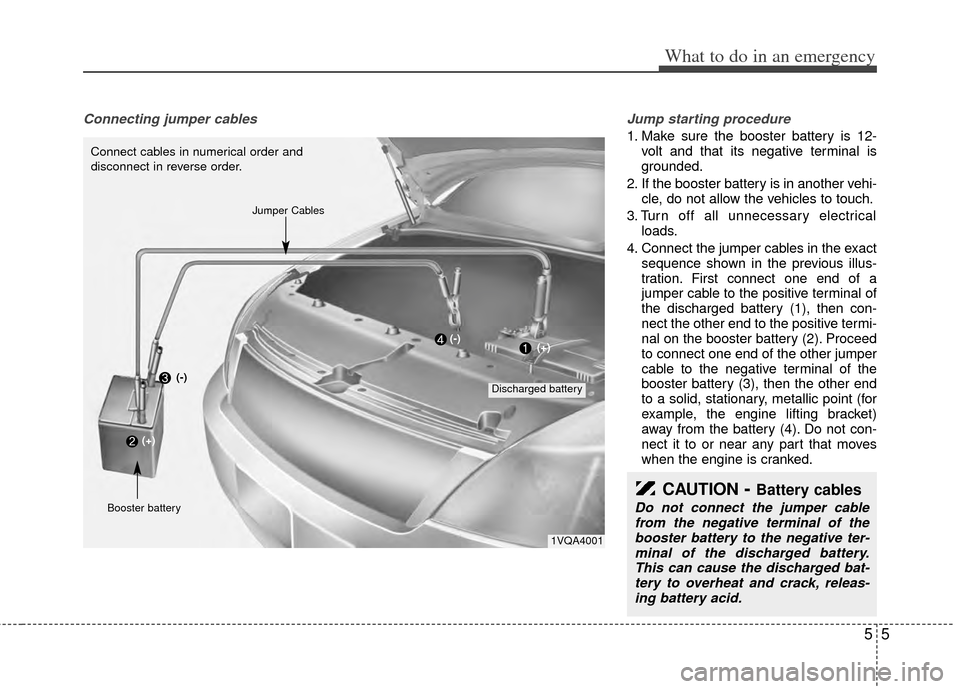
55
What to do in an emergency
Connecting jumper cables Jump starting procedure
1. Make sure the booster battery is 12-
volt and that its negative terminal is
grounded.
2. If the booster battery is in another vehi- cle, do not allow the vehicles to touch.
3. Turn off all unnecessary electrical loads.
4. Connect the jumper cables in the exact sequence shown in the previous illus-
tration. First connect one end of a
jumper cable to the positive terminal of
the discharged battery (1), then con-
nect the other end to the positive termi-
nal on the booster battery (2). Proceed
to connect one end of the other jumper
cable to the negative terminal of the
booster battery (3), then the other end
to a solid, stationary, metallic point (for
example, the engine lifting bracket)
away from the battery (4). Do not con-
nect it to or near any part that moves
when the engine is cranked.
CAUTION- Battery cables
Do not connect the jumper cablefrom the negative terminal of the booster battery to the negative ter-minal of the discharged battery.This can cause the discharged bat-tery to overheat and crack, releas- ing battery acid.
1VQA4001
Connect cables in numerical order and
disconnect in reverse order.
Discharged battery
Jumper Cables
Booster battery(-)
(+)
(+)(-)
Page 302 of 382
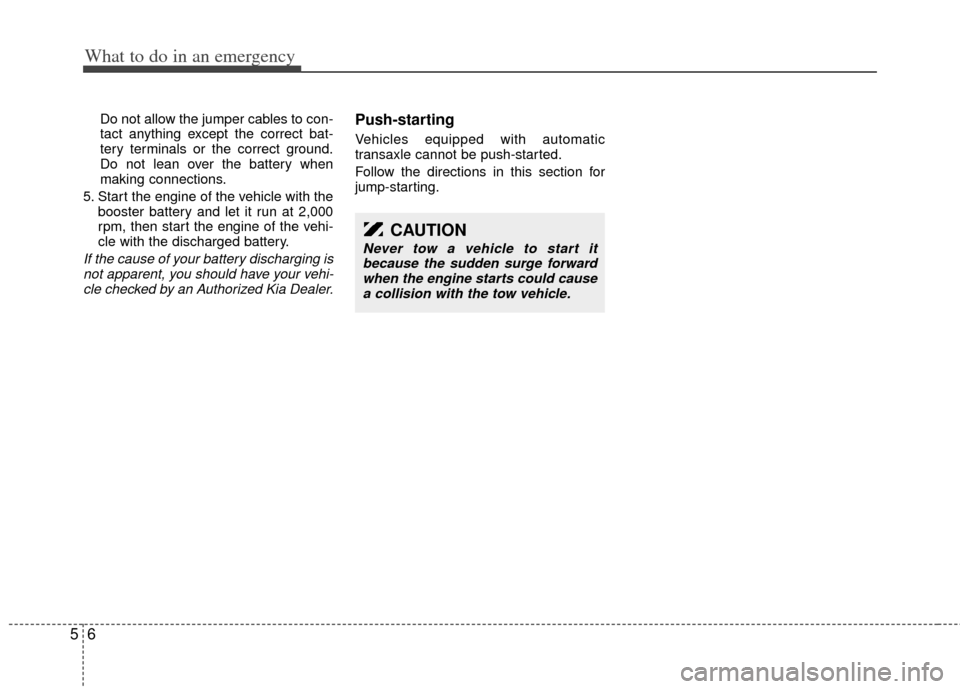
What to do in an emergency
65
Do not allow the jumper cables to con-
tact anything except the correct bat-
tery terminals or the correct ground.
Do not lean over the battery when
making connections.
5. Start the engine of the vehicle with the booster battery and let it run at 2,000
rpm, then start the engine of the vehi-
cle with the discharged battery.
If the cause of your battery discharging isnot apparent, you should have your vehi-cle checked by an Authorized Kia Dealer.
Push-starting
Vehicles equipped with automatic
transaxle cannot be push-started.
Follow the directions in this section for
jump-starting.
CAUTION
Never tow a vehicle to start itbecause the sudden surge forward when the engine starts could causea collision with the tow vehicle.
Page 377 of 382
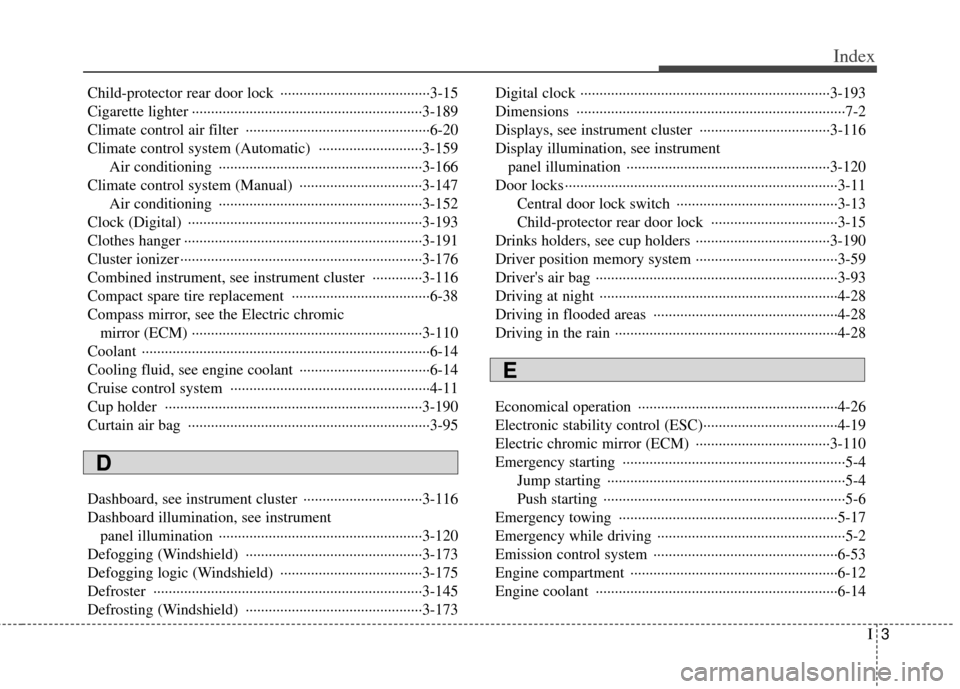
I3
Index
Child-protector rear door lock ··················\
··················\
···3-15
Cigarette lighter ··················\
··················\
··················\
······3-189
Climate control air filter ··················\
··················\
············6-20
Climate control system (Automatic) ··················\
·········3-159Air conditioning ··················\
··················\
·················3-16\
6
Climate control system (Manual) ··················\
··············3-147 Air conditioning ··················\
··················\
·················3-15\
2
Clock (Digital) ··················\
··················\
··················\
·······3-193
Clothes hanger ··················\
··················\
··················\
········3-191
Cluster ionizer ··················\
··················\
··················\
·········3-176
Combined instrument, see instrument cluster ·············3-116
Compact spare tire replacement ··················\
··················\
6-38
Compass mirror, see the Electric chromic mirror (ECM) ···············\
··················\
··················\
·········3-110
Coolant ················\
··················\
··················\
··················\
·····6-14
Cooling fluid, see engine coolant ··················\
················6-14
Cruise control system ··················\
··················\
················4-11
Cup holder ··················\
··················\
··················\
·············3-190
Curtain air bag ··················\
··················\
··················\
·········3-95
Dashboard, see instrument cluster ··················\
·············3-116
Dashboard illumination, see instrument panel illumination ··················\
··················\
·················3-12\
0
Defogging (Windshield) ··················\
··················\
··········3-173
Defogging logic (Windshield) ··················\
··················\
·3-175
Defroster ················\
··················\
··················\
··················\
3-145
Defrosting (Windshield) ··················\
··················\
··········3-173 Digital clock ··················\
··················\
··················\
···········3-193
Dimensions ················\
··················\
··················\
··················\
7-2
Displays, see instrument cluster ··················\
················3-116
Display illumination, see instrument
panel illumination ··················\
··················\
·················3-12\
0
Door locks ··················\
··················\
··················\
·················3-11\
Central door lock switch ··················\
··················\
······3-13
Child-protector rear door lock ··················\
···············3-15
Drinks holders, see cup holders ··················\
·················3-19\
0
Driver position memory system ··················\
··················\
·3-59
Driver's air bag ··················\
··················\
··················\
·········3-93
Driving at night ··················\
··················\
··················\
········4-28
Driving in flooded areas ··················\
··················\
············4-28
Driving in the rain ··················\
··················\
··················\
····4-28
Economical operation ··················\
··················\
················4-26
Electronic stability control (ESC)··················\
·················4-19\
Electric chromic mirror (ECM) ··················\
·················3-11\
0
Emergency starting ··················\
··················\
··················\
····5-4 Jump starting ··················\
··················\
··················\
········5-4
Push starting ··················\
··················\
··················\
·········5-6
Emergency towing ··················\
··················\
··················\
···5-17
Emergency while driving ··················\
··················\
·············5-2
Emission control system ··················\
··················\
············6-53
Engine compartment ··················\
··················\
··················\
6-12
Engine coolant ··················\
··················\
··················\
·········6-14
D
E
Page 379 of 382
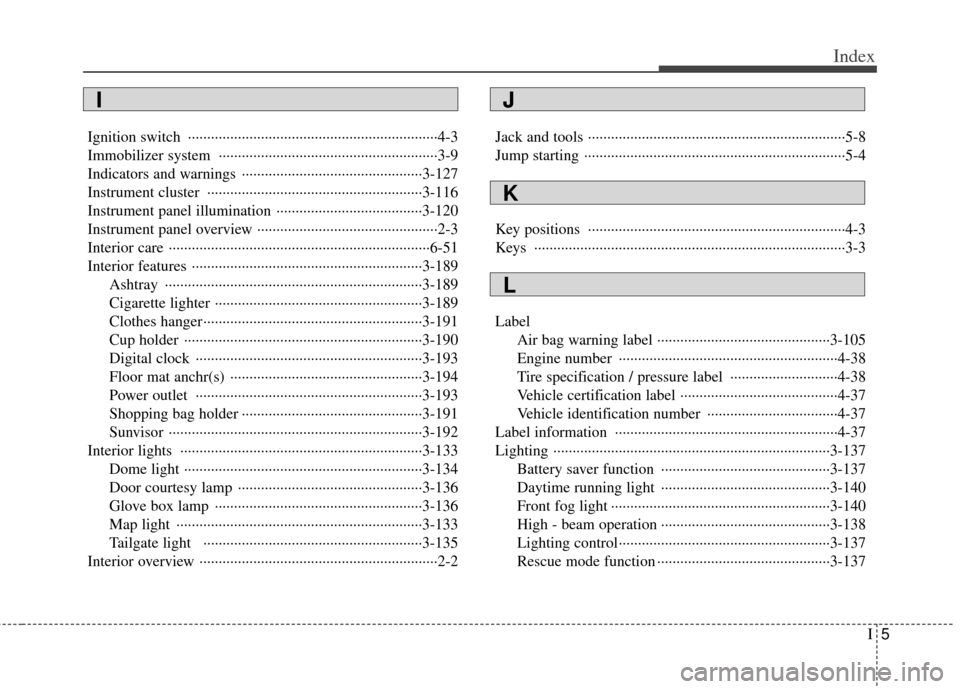
I5
Index
Ignition switch ··················\
··················\
··················\
···········4-3
Immobilizer system ··················\
··················\
··················\
···3-9
Indicators and warnings ··················\
··················\
···········3-127
Instrument cluster ··················\
··················\
··················\
··3-116
Instrument panel illumination ··················\
··················\
··3-120
Instrument panel overview ··················\
··················\
···········2-3
Interior care ··················\
··················\
··················\
··············6-51
Interior features ··················\
··················\
··················\
······3-189Ashtray ················\
··················\
··················\
···············3-189
Cigarette lighter ··················\
··················\
··················\
3-189
Clothes hanger··················\
··················\
··················\
···3-191
Cup holder ··················\
··················\
··················\
········3-190
Digital clock ··················\
··················\
··················\
·····3-193
Floor mat anchr(s) ··················\
··················\
··············3-194
Power outlet ··················\
··················\
··················\
·····3-193
Shopping bag holder ··················\
··················\
···········3-191
Sunvisor ·················\
··················\
··················\
·············3-192
Interior lights ··················\
··················\
··················\
·········3-133 Dome light ··················\
··················\
··················\
········3-134
Door courtesy lamp ··················\
··················\
············3-136
Glove box lamp ··················\
··················\
··················\
3-136
Map light ··················\
··················\
··················\
··········3-133
Tailgate light ··················\
··················\
··················\
···3-135
Interior overview ··················\
··················\
··················\
········2-2 Jack and tools ··················\
··················\
··················\
·············5-8
Jump starting ··················\
··················\
··················\
··············5-4
Key positions ··················\
··················\
··················\
·············4-3
Keys ··················\
··················\
··················\
··················\
·········3-3
Label
Air bag warning label ··················\
··················\
·········3-105
Engine number ··················\
··················\
··················\
···4-38
Tire specification / pressure label ··················\
··········4-38
Vehicle certification label ··················\
··················\
·····4-37
Vehicle identification number ··················\
················4-37
Label information ··················\
··················\
··················\
····4-37
Lighting ················\
··················\
··················\
··················\
··3-137 Battery saver function ··················\
··················\
········3-137
Daytime running light ··················\
··················\
········3-140
Front fog light ··················\
··················\
··················\
···3-140
High - beam operation ··················\
··················\
········3-138
Lighting control··················\
··················\
··················\
·3-137
Rescue mode function ··················\
··················\
·········3-137
K
J
L
I